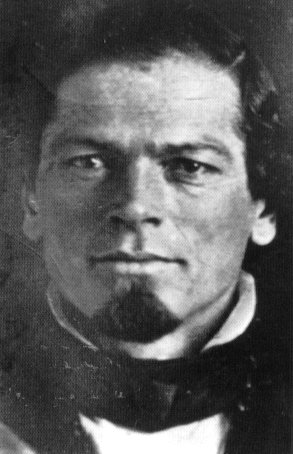New Worlds to Seek
Today, we watch a new world being formed. The University of Houston's College of Engineering presents this series about the machines that make our civilization run, and the people whose ingenuity created them.
Great-grandfather Heinrich Lienhard came to America from Switzerland in 1843. He was just twenty-one and hungry for more than a life spent farming the foothills of the Glarner Alps. His accounts of crossing the prairie on foot, and working with Sutter during the discovery of gold, are available in several books. But now the story of his emigration to America has been published under the title New Worlds to Seek. And we gain a powerful, intimate look at the nineteenth-century immigrant experience.
First, we watch as restless discontent drives a lad out of his small valley and off to a frontier halfway around the world. Heinrich leaves Le Havre in steerage on the sailing ship Narragansett, bound for New Orleans. The only entertainment is communal singing. During weeks at sea, he complains as much about shipmates who sing out of tune as he does about seasickness. Still, he's a keen observer of human nature and all things around him.
When the ship reaches Louisiana, a steam-driven tug hauls it up the delta to New Orleans. Along the way, passengers get out and chop wood to fuel the tug. One of the first new-world surprises for Heinrich is a surprise for us as well. It's the American axe, the axe you and I know, with its curved handle and counterweighted head. His eye immediately lands on the axe that opened up our wilderness.
Heinrich's odyssey then moves up the Mississippi. He works on a farm in Illinois. He tries woodcutting in Minnesota. Always some new trade -- some new survival skill. Wages run about five dollars a week. A meal costs fifteen cents, and it's usually just this side of inedible. It's a world of bed bugs, fever, and hardship. He's like Candide, trying to wear his innocence in a world where deceit or violence might arise any moment.
The most famous stories of this time and place -- Tom Sawyer and Huckleberry Finn -- are anachronistic. They're supposed to be about the 1840s, but Mark Twain describes technologies of a later and more settled world. Dickens, who visited the Mississippi in 1840, gives a better picture of the harsh life.
No one in Heinrich's saga quite knows how to manage. Everyone struggles as they have to leave old technologies behind and create new ones for a new land. No one can quite figure out whom to trust and whom to fear. The Indians Heinrich meets turn out not at all like the savages he's heard about. He's never known black people, and you taste his surprise when, hopelessly lost, wet, and hungry in Illinois, it's a black family that finally feeds him.
We often speak of people going west. It's quite another matter to relive the process hurdle by hurdle -- to watch technologies of everyday life evolve. God, we are told, lives in the details. Well, here in the vast sweep of detail, we get to see a new civilization forming with stunning speed -- and forming out of seeming chaos.
I'm John Lienhard, at the University of Houston, where we're interested in the way inventive minds work.
(Theme music)
Lienhard, H., New Worlds to Seek. (tr. Raymond J. Spahn, ed. John C. Abbot, Foreword by John H. Lienhard IV). Carbondale, IL: Southern Illinois University Press, 2000.
Lienhard, H., From St. Louis to Sutter's Fort. 1846. (tr. and ed. by E.G. and E.K. Gudde). Norman, OK: University of Oklahoma Press, 1959, Chapter 14.
Lienhard, H., A Pioneer at Sutter's Fort. 1846-1850: The Adventures of Heinrich Lienhard. (Translated, edited, and Annotated by M.E. Wilbur). Los Angeles: the Calafia Society, 1941.

Heinrich Lienhard as young man